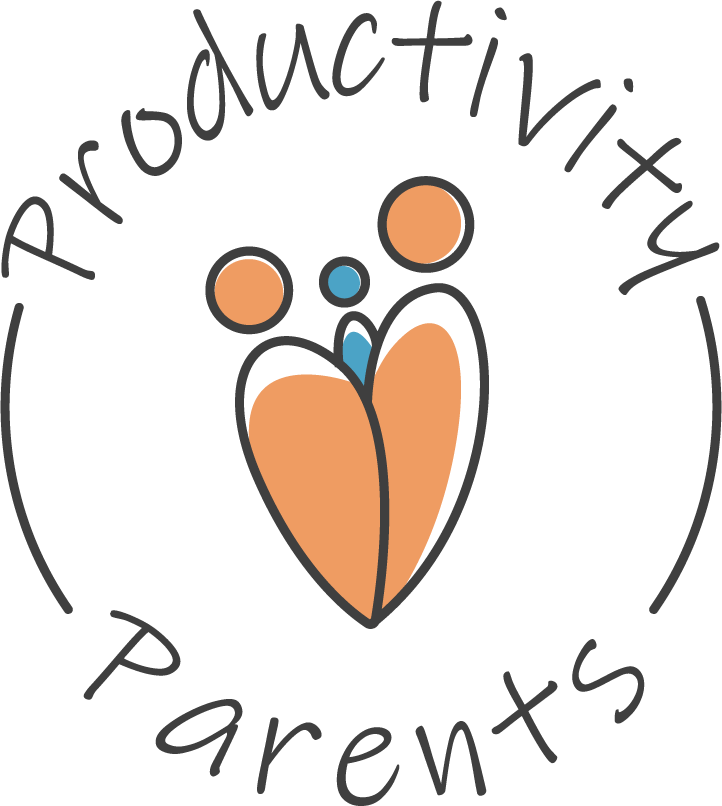In today’s fast-paced world, managing both household and work responsibilities can feel overwhelming without the right systems in place. I’ve discovered that collaboration tools offer a powerful solution for coordinating tasks, deadlines, and responsibilities across all areas of life. By implementing digital collaboration platforms, you can reduce miscommunication, eliminate redundant efforts, and create seamless workflows that save hours each week.
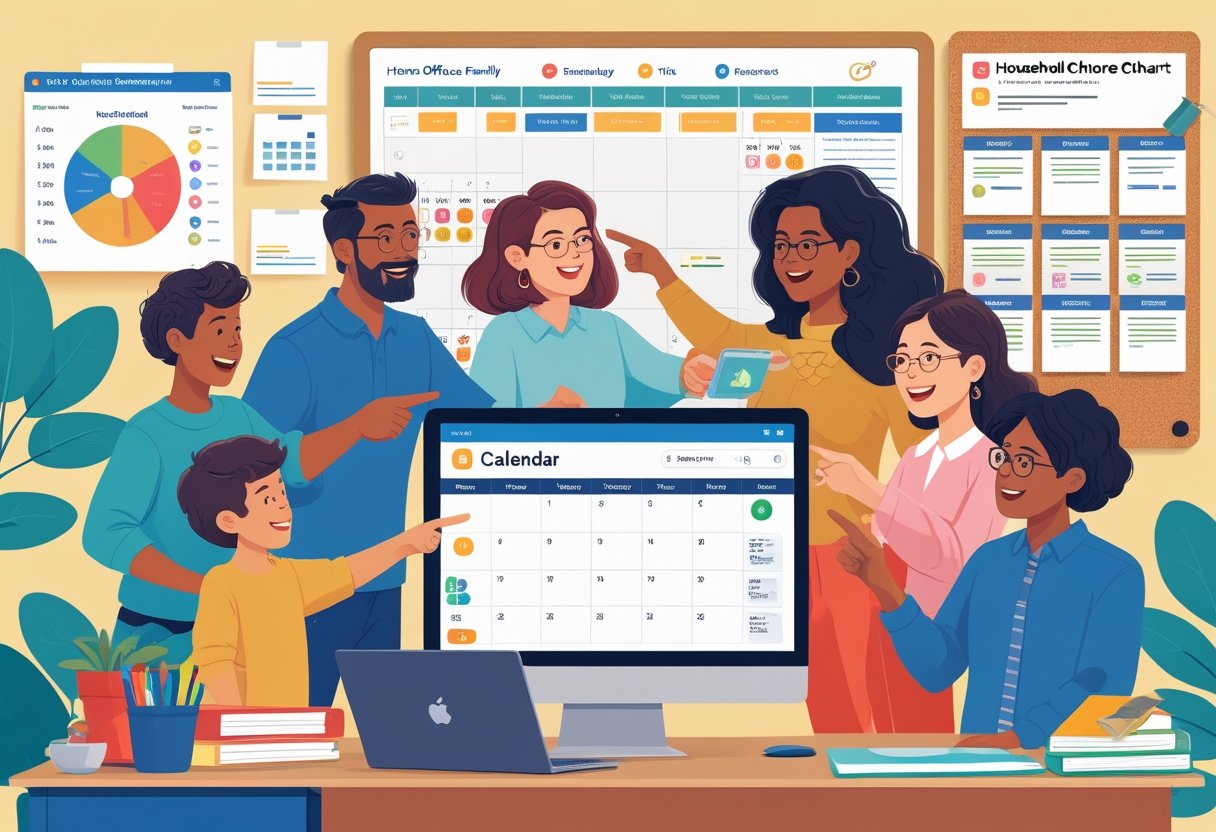
The transition to digital task management has transformed how I approach everything from grocery shopping to major work projects. These tools create a central hub where family members or colleagues can view responsibilities, track progress, and communicate updates in real-time. The result is fewer forgotten tasks, clearer accountability, and a significant reduction in the mental load that comes with keeping track of numerous responsibilities.
Key Takeaways
- Collaboration tools centralize communication and task management, reducing the mental burden of tracking responsibilities across work and home environments.
- Digital platforms enable real-time updates and accountability, helping family members and colleagues stay aligned on priorities and deadlines.
- Implementing the right collaboration tools can save significant time by eliminating redundant efforts and creating automated workflows for recurring tasks.
Understanding Collaboration Tools
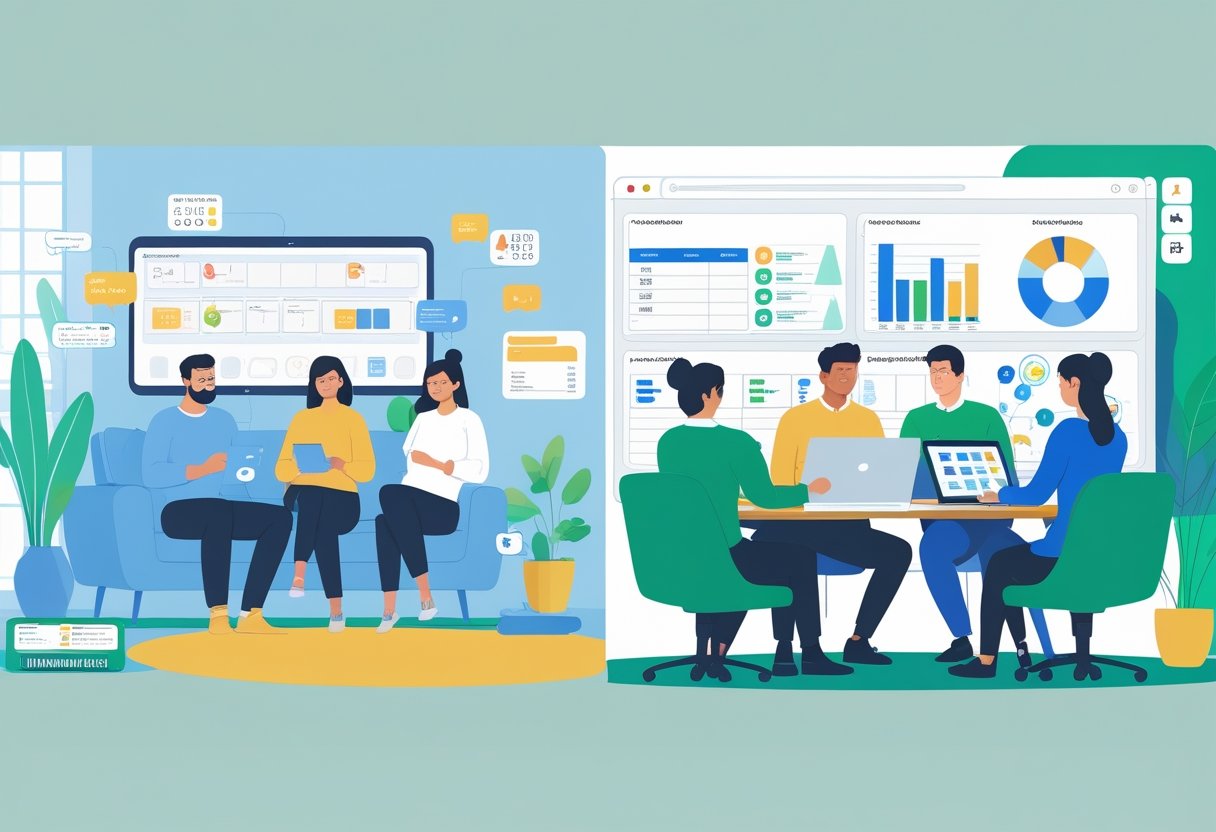
Collaboration tools serve as digital workspaces that connect people and streamline processes across distances. They fundamentally change how families coordinate household responsibilities and how teams accomplish work projects.
What Are Collaboration Tools
Collaboration tools are digital applications and platforms that enable people to communicate, share information, and work together effectively regardless of physical location. These technologies offer real-time messaging, group chat, file sharing, and project coordination capabilities that break down communication barriers.
I’ve found that good collaboration tools act as central hubs where all project information, conversations, and tasks live together. They eliminate the chaos of scattered emails, lost text messages, and misplaced notes.
For families, these tools can transform how we manage household responsibilities, from coordinating schedules to planning meals. In professional settings, they create virtual workspaces where teams can collaborate seamlessly.
The best collaboration systems balance functionality with simplicity, providing powerful features without overwhelming users with complexity.
Types of Collaboration Platforms
Several distinct categories of collaboration platforms exist, each designed to address specific collaboration needs:
I’ve noticed that many households benefit from simpler tools like shared calendars and task lists, while businesses often require more robust platforms with advanced security and integration capabilities.
The right choice depends entirely on your specific needs, team size, and the complexity of your projects.
Core Features and Functionalities
Effective collaboration tools share several essential features that make teamwork more efficient:
- Real-time communication: Instant messaging, video conferencing, and discussion boards
- File sharing and storage: Secure document management with version control
- Task management: Assignment creation, progress tracking, and deadline notifications
- Calendar integration: Schedule coordination and meeting planning
- Search functionality: Quick retrieval of past conversations and documents
I’ve found that the most valuable collaboration tools also offer cloud computing capabilities that provide access from any device at any time. This flexibility is crucial for both family coordination and professional teamwork.
Modern platforms increasingly incorporate AI features that can automate routine tasks, suggest optimal meeting times, or highlight important information. Many also offer customization options through integrations with other software you already use.
Security features like access controls and data encryption are non-negotiable for protecting sensitive information, especially in professional contexts.
Benefits of Using Collaboration Tools for Productivity
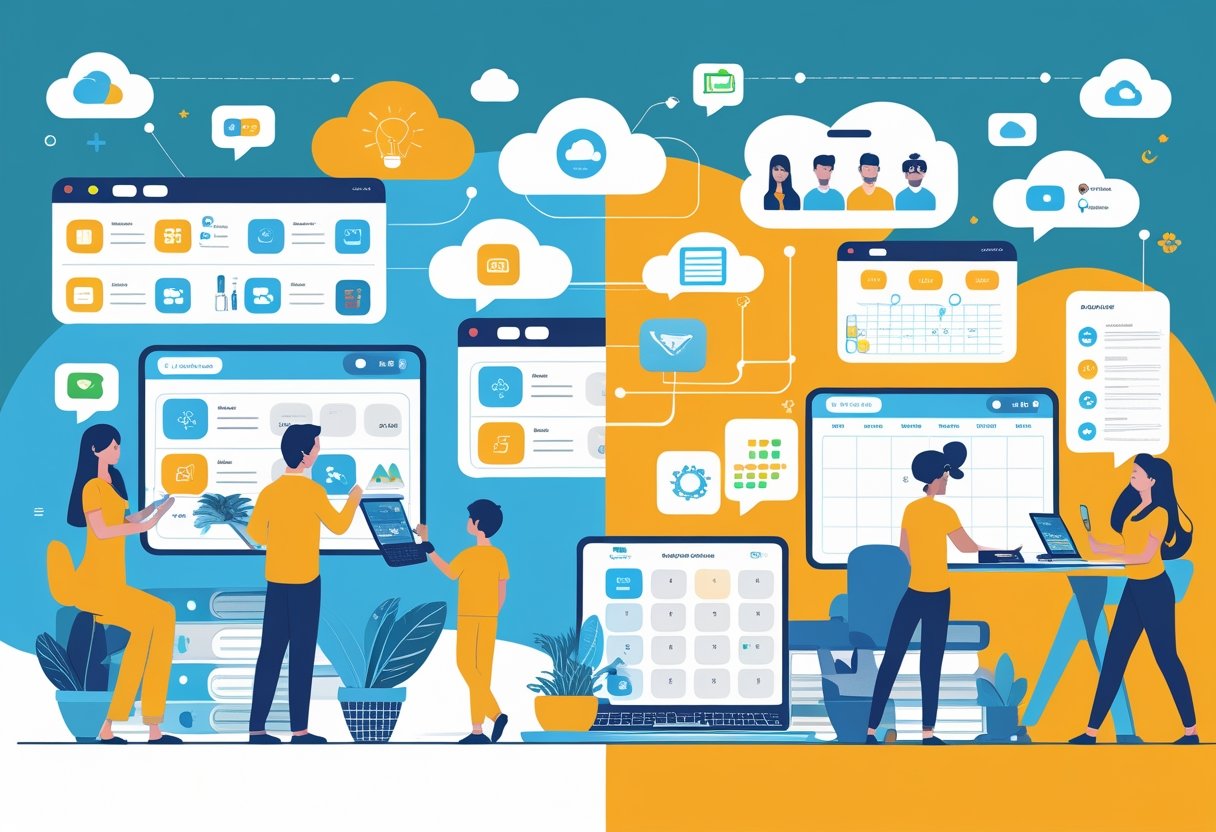
Modern collaboration tools offer significant advantages across different aspects of daily life through improved organization, communication, and accountability features. I’ve found these tools fundamentally change how tasks are managed and completed both at home and work.
Time Management Improvements
Collaboration tools dramatically reduce time spent on routine coordination tasks. I’ve discovered that streamlined task management and workflow automation can save hours each week by eliminating redundant activities.
Rather than sending multiple emails to coordinate schedules, I now use shared calendars and task boards to instantly update everyone involved. This prevents confusion and duplicate efforts.
The ability to centralize information means I spend less time searching for documents or instructions. Instead of digging through old emails, I can quickly access everything in one organized platform.
Many tools offer pre-designed templates that eliminate starting from scratch each time. I’ve found this particularly useful for recurring projects, where the same structure can be reused with minimal adjustments.
Enhanced Communication
Collaboration platforms create clearer communication channels that reduce misunderstandings. I can now work together in real time with others regardless of location, making distance irrelevant to productivity.
File sharing capabilities eliminate version control problems. Instead of emailing attachments back and forth, I edit the same document simultaneously with teammates, seeing changes as they happen.
Key communication improvements I’ve experienced:
- Instant feedback on projects
- Reduced email volume and inbox clutter
- Context-specific discussions attached to relevant tasks
- Clearer delegation of responsibilities
Video conferencing and integrated messaging keep conversations flowing naturally, preserving the human element that’s often lost in text-only communication.
Increased Accountability
Task tracking features have transformed how I monitor progress and maintain responsibility. I can now assign specific tasks to household members or colleagues with clear deadlines and priority levels.
The visibility provided by collaboration tools means nothing falls through the cracks. I can quickly see what’s completed, what’s in progress, and what’s falling behind schedule without asking for updates.
Clear task assignments have eliminated the “I thought someone else was doing that” problem that previously plagued group projects. Everyone can see their responsibilities displayed prominently.
Progress tracking creates positive peer pressure. When everyone can see task status, I’ve noticed people are more motivated to complete their portion on time.
Automatic notifications ensure I never miss important deadlines, creating a system of gentle reminders that keep projects moving forward without constant manual oversight.
Collaboration Tools for Household Task Management
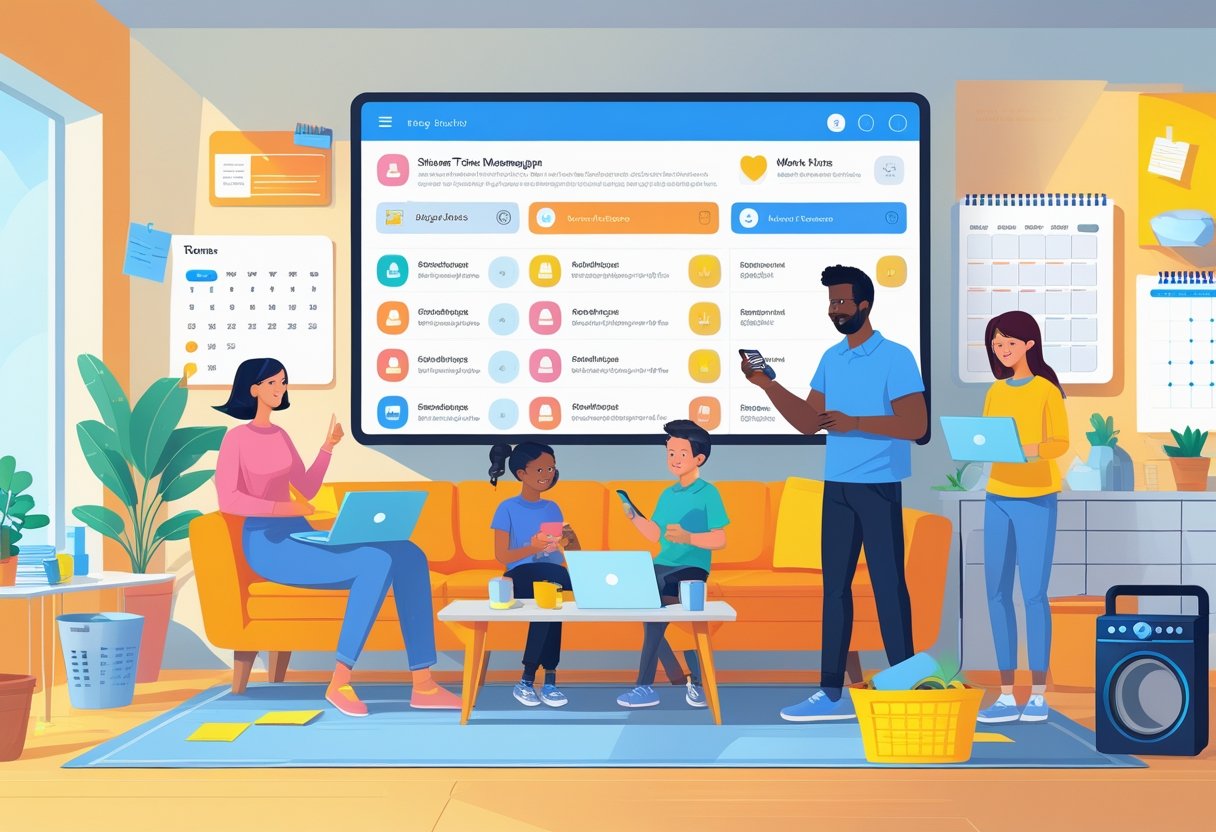
Managing household tasks effectively requires digital solutions that enable all family members to stay coordinated and informed. The right tools can transform chaotic home management into streamlined systems where everyone knows their responsibilities.
Coordinating Chores and Responsibilities
I’ve found that specialized household management platforms significantly reduce family friction around chores. Nines household management software allows me to create and assign tasks to family members or household staff with clear accountability.
Family chore apps typically offer these essential features:
- Task rotation schedules that automatically cycle responsibilities
- Verification systems where tasks can be marked complete with photo evidence
- Reward systems to motivate younger family members
I particularly value the notification features in these apps. When someone completes their assigned task, I receive an alert without having to check manually. This eliminates the need for constant verbal reminders.
For households with staff or regular contractors, these platforms provide professional oversight while maintaining respectful boundaries and clear expectations.
Organizing Family Schedules
Shared calendar applications form the backbone of well-coordinated household scheduling. I sync these with multiple devices so everyone can access up-to-date information regardless of location.
Key features I recommend looking for include:
- Color-coding for different family members
- Recurring event settings for regular activities
- Integration with other household management tools
- Notification settings customized by event importance
When evaluating calendar tools, I prioritize those with conflict detection that alert me when someone tries to schedule overlapping commitments. This prevents double-booking and helps identify potential scheduling issues before they create problems.
Notion’s intuitive interface allows me to build custom calendar views that work for my specific family dynamics, combining scheduling with other household information in one accessible location.
Sharing Shopping and To-Do Lists
Collaborative list applications have revolutionized my household shopping and task management. I create categorized shopping lists that any family member can access and update in real-time.
The most effective shopping list features include:
- Store-specific organization that sorts items by shopping location
- Voice input for quick additions while busy with other tasks
- Recurring item suggestions based on purchase history
- Shared access so anyone can add items as needed
I use these same platforms for general household to-do lists, creating both individual responsibilities and shared project lists. The best apps allow for priority flagging so urgent tasks stand out.
When a family member is at the store, they can check off items as they shop, giving everyone else real-time visibility into what’s been purchased and what remains needed.
Monitoring Household Projects
For more complex household undertakings, I leverage project management tools designed for home use. These platforms help me track renovation projects, seasonal maintenance, and large organizational efforts.
Effective home project features include:
- Timeline visualization for project phases
- Budget tracking capabilities
- Document storage for warranties and manuals
- Vendor/contractor contact management
ActiveCollab offers powerful task and project management that scales well for household needs. I find its billing management particularly useful when tracking contractor payments and project expenses.
I also appreciate tools that let me attach photos to document project progress or maintenance issues. This visual record proves invaluable when communicating with contractors or tracking changes over time.
Optimizing Work Tasks With Collaboration Platforms
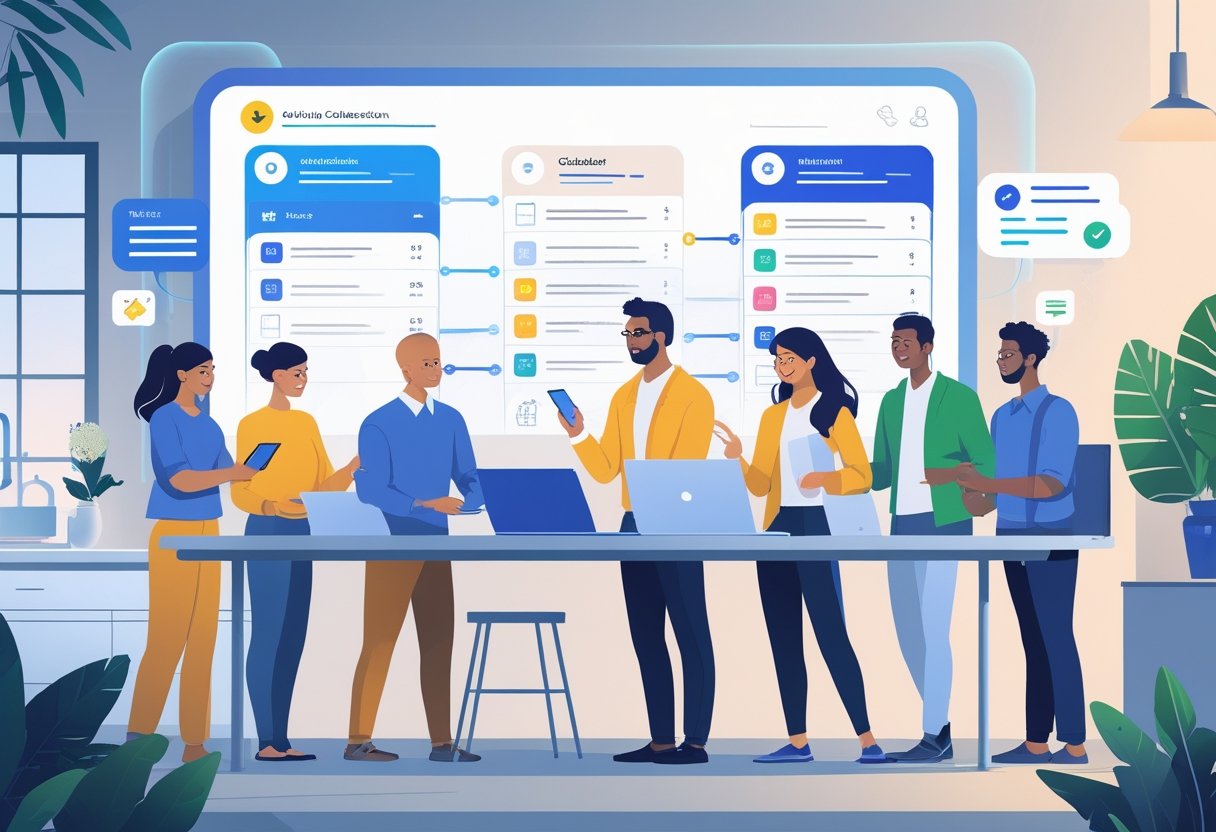
Effective collaboration tools help me streamline daily workflows and significantly boost productivity. I’ve found that the right digital platforms can transform how teams communicate, share information, and track progress on projects.
Team Project Tracking
When managing complex projects, I rely on comprehensive tracking tools to maintain visibility across all moving parts. Platforms like Asana, Trello, and Salesforce integrate seamlessly with Microsoft Teams for a unified workflow experience.
I find these tools particularly valuable for:
- Timeline visualization: Gantt charts help me see project phases at a glance
- Milestone tracking: Automatic notifications keep everyone aware of important deadlines
- Progress reporting: Real-time dashboards eliminate the need for status update meetings
The best collaboration solutions allow me to plan and refine workflows both individually and as a team. This forward-planning capability ensures everyone understands their roles and responsibilities.
I’ve noticed team accountability improves dramatically when everyone can see task dependencies and project bottlenecks in one centralized location.
Document Sharing and Co-Editing
Real-time document collaboration has transformed how I approach content creation and review cycles. Cloud-based solutions enable my team to work on the same files simultaneously, regardless of location.
When evaluating document sharing platforms, I prioritize:
- Version control – Tracking changes and reverting when needed
- Permission settings – Controlling who can view, edit or comment
- Comment functionality – Facilitating specific feedback on content
These features improve teamwork by enabling real-time collaboration regardless of team members’ locations. I’ve found that digital asset management systems provide additional organization for complex document libraries.
The ability to co-edit documents has reduced my email volume significantly. Instead of sending attachments back and forth, I can simply share a link and watch as collaborators make their contributions in real time.
Task Assignment and Prioritization
Effective task management requires clear assignment processes and prioritization systems. I use collaboration platforms to ensure everyone knows exactly what they’re responsible for and when it’s due.
My task management approach includes:
| Task clarity | Task priority | Task progress |
|---|---|---|
| Detailed descriptions | Priority flags (High/Medium/Low) | Percentage complete |
| Due dates with time | Dependencies identified | Status updates |
| Assigned owners | Time estimates | Blockers flagged |
By streamlining task collaboration, I’ve improved project outcomes and team communication. The most effective platforms allow for task dependencies to be clearly mapped.
I make sure to fine-tune these collaborative tools for our hybrid work environment, focusing on user experience and business results. Clear prioritization systems help team members understand what to focus on first.
Popular Collaboration Tools for Households and Workplaces
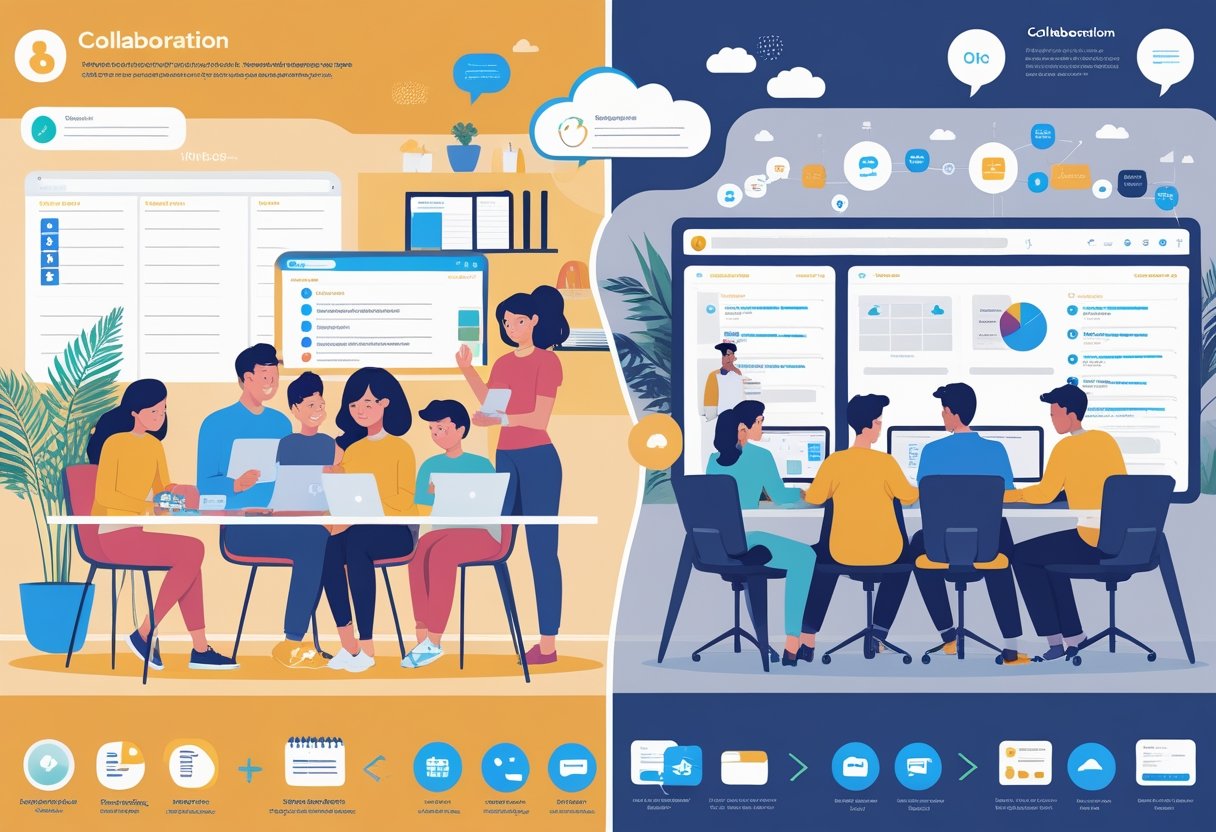
Today’s digital landscape offers numerous tools that can streamline both household management and workplace productivity. These platforms vary in functionality, price point, and user experience, but the best ones provide seamless communication, task management, and file sharing capabilities.
Overview of Leading Apps
Slack remains one of the most popular communication tools for teams, offering organized conversations through channels and direct messages. I’ve found it particularly effective for quick team check-ins and file sharing.
For task management, Asana stands out with its intuitive interface and flexibility for both work and home projects. It allows me to track responsibilities and deadlines with visual clarity.
Trello offers a simpler kanban-style approach that works well for visual thinkers. I appreciate its drag-and-drop interface for managing everything from grocery lists to complex work projects.
Notion combines note-taking, wikis, and task management in one platform. I’ve used it successfully for both family documentation and work knowledge bases.
Microsoft 365 provides comprehensive tools including Teams for communication and SharePoint for document management, making it ideal for more structured environments.
Key Features Comparison
| Tool | Communication | Task Management | File Sharing | Calendar | AI Features |
|---|---|---|---|---|---|
| Slack | ★★★★★ | ★★☆☆☆ | ★★★★☆ | ★★☆☆☆ | ★★★☆☆ |
| Asana | ★★★☆☆ | ★★★★★ | ★★★☆☆ | ★★★★☆ | ★★★☆☆ |
| Trello | ★★☆☆☆ | ★★★★☆ | ★★☆☆☆ | ★★☆☆☆ | ★★☆☆☆ |
| Notion | ★★☆☆☆ | ★★★★☆ | ★★★★☆ | ★★★☆☆ | ★★★☆☆ |
| Microsoft 365 | ★★★★☆ | ★★★☆☆ | ★★★★★ | ★★★★★ | ★★★★☆ |
I’ve noticed that AI features are becoming increasingly important in 2025. For example, Clockwise uses AI to optimize scheduling and protect focused work time, which I find invaluable for maintaining productivity.
For households, I recommend tools with simpler interfaces like Trello or Notion, while workplaces may benefit from more robust solutions like Hive or Microsoft 365 depending on team size and complexity.
Integration Capabilities
The most effective collaboration tools don’t exist in isolation. I’ve found that tools with strong integration capabilities significantly reduce context switching and improve workflow efficiency.
Slack excels with over 2,000 app integrations, allowing me to connect tools like Google Drive, Zoom, and project management platforms within a single interface. This creates a central hub for most work activities.
Cloud computing software platforms like Google Workspace and Microsoft 365 offer native integrations within their ecosystems, which I find particularly valuable for document collaboration and real-time editing.
For household management, I prefer tools that integrate with calendar apps and smart home devices. Many collaboration platforms now offer mobile apps with notification systems that help me stay coordinated with family members.
API access is another crucial factor for customization. Zapier connections can automate workflows between different tools, saving me considerable time on repetitive tasks both at home and work.
Implementing Collaboration Tools Effectively
Successful implementation of collaboration tools requires careful planning and consistent usage patterns. I’ve found that proper onboarding, customization for specific environments, and establishing clear guidelines are the critical factors that determine whether these digital solutions enhance or complicate your workflow.
Onboarding and Training
I always begin with a proper introduction to any new collaboration tool. I schedule dedicated time to explore features rather than trying to learn while working on critical tasks. Most platforms offer free tutorials or webinars that provide excellent starting points.
I create simple cheat sheets for family members or colleagues that highlight the most relevant functions for our specific needs. These quick-reference guides prevent frustration and increase adoption rates.
For households, I’ve found that 15-minute demonstration sessions work well. At work, I organize more structured training in small groups where team members can ask questions and practice together.
I also designate “power users” who can provide ongoing support to others. This fosters teamwork and creates a support system that makes everyone more comfortable with the technology.
Customizing for Household vs. Work Needs
I adapt collaboration tools differently based on whether I’m managing home or work tasks. For household use, I focus on simplicity and accessibility for all family members regardless of tech comfort level.
At home, I create:
- Shared calendars with color-coding for each family member
- Digital shopping lists that anyone can update in real-time
- File storage for important household documents
- Simple task boards for chores and household projects
For work environments, I utilize more sophisticated features that enhance productivity. I implement project tracking with deadlines, document version control, and advanced permission settings to maintain appropriate access levels.
I’ve found that unified communications platforms work best when customized with templates and workflows that match existing processes rather than forcing changes to accommodate the tool.
Establishing Best Practices
I create clear guidelines to prevent collaboration tools from becoming sources of distraction. These standards help maintain consistency and maximize effectiveness.
My essential best practices include:
- Notification management: I configure alerts only for truly important updates
- Naming conventions: I use consistent file naming patterns for easy searching
- Update frequency: I establish expectations for how often everyone should check and respond
- Response time standards: I set realistic timeframes for replies based on urgency
I regularly audit tool usage to identify underutilized features or unnecessary complications. This helps me simplify our digital workspace and maintain focus on what actually works.
I also establish boundaries between work and personal time by using digital platforms designed for specific purposes rather than letting all communications flow through a single channel. This prevents work from constantly bleeding into personal time.
Overcoming Common Challenges With Collaboration Tools
While collaboration tools boost productivity, they present several obstacles that can hinder their effectiveness. I’ve identified key strategies to address privacy concerns, prevent digital fatigue, and overcome adoption resistance in household and work environments.
Ensuring Data Privacy and Security
I always verify a tool’s privacy policy before implementation, especially for family calendars or work projects containing sensitive information. Leading platforms like Asana offer robust security features that protect data while maintaining accessibility.
I recommend implementing these privacy practices:
- Use strong, unique passwords for each collaboration tool
- Enable two-factor authentication whenever available
- Regularly review permission settings and user access
- Choose tools that offer end-to-end encryption
For family use, I’m careful about what information children can access or share. When handling work documents, I select platforms with granular permission controls to ensure only authorized team members can view confidential information.
Managing Digital Overload
The constant stream of notifications from collaboration tools can quickly become overwhelming. I’ve found that poor information flow ranks among the top collaboration challenges.
To combat digital fatigue, I:
- Customize notification settings for each platform
- Designate specific check-in times rather than responding immediately
- Create clear communication guidelines with family or colleagues
When managing multiple projects, I use integrated dashboards to consolidate information. This prevents the constant app-switching that drains mental energy.
I also practice digital detox periods where I disconnect completely from collaboration tools. This helps maintain focus and prevents burnout while ensuring I’m present for both family and work responsibilities.
Handling Resistance to Adoption
I often encounter reluctance when introducing new collaboration tools to family members or colleagues. This resistance typically stems from comfort with existing methods or fear of technology.
My approach to overcoming adoption challenges:
- Start small with one tool that addresses a specific pain point
- Provide simple tutorials tailored to different technical skill levels
- Highlight immediate benefits that matter to each person
For older family members, I demonstrate how digital calendars eliminate paper clutter. With colleagues, I emphasize how tools like Slack can reduce email overload and streamline decision-making.
I’ve learned that celebrating small wins builds momentum. When someone successfully uses a tool to solve a problem, I acknowledge their progress, which encourages continued adoption.
Frequently Asked Questions
Collaboration tools have transformed how we manage tasks at home and work, with many people having specific questions about implementation and benefits. I’ve answered the most common questions I receive about digital collaboration platforms below.
What are the advantages of using free collaboration tools for remote teams?
Free collaboration tools offer remote teams significant cost savings while still providing essential functionality. Teams can communicate effectively without investing in expensive software licenses.
Many free tools include task management features, file sharing capabilities, and basic communication functions that meet the needs of small to medium teams. These platforms help maintain productivity without financial strain.
Free collaboration solutions often serve as excellent starting points for organizations testing digital workflows before committing to paid enterprise solutions. They allow teams to experiment with different collaboration methods without financial risk.
How can Microsoft Teams enhance productivity and collaboration within a workplace?
Microsoft Teams centralizes communication by combining chat, video meetings, and file sharing in one platform, eliminating the need to switch between multiple applications. This integration saves valuable time during workdays.
The platform’s seamless connection with other Microsoft 365 applications allows for real-time document collaboration and editing. Teams members can simultaneously work on Excel spreadsheets, Word documents, and PowerPoint presentations without version control issues.
Microsoft Teams also excels at keeping track of tasks and deadlines through its integration with Planner and other project management tools. This visibility helps teammates stay accountable and projects remain on schedule.
What are the best practices for integrating digital collaborative tools into personal and professional routines?
Start by clearly identifying the problem your organization is trying to solve before selecting tools. Understanding your specific needs prevents tool overload and ensures adoption of relevant solutions.
Establish consistent communication protocols that define which tools to use for different types of interactions. For example, determine when to use chat versus email versus video calls to reduce confusion.
Invest time in proper training to ensure all team members understand how to use collaboration tools effectively. Regular practice sessions and documentation help overcome resistance to new technology.
In what ways can virtual collaboration tools positively affect remote work and study environments?
Virtual collaboration tools break down geographical barriers, enabling teams to work together regardless of physical location. This flexibility supports diverse hiring practices and accommodates various work-life balance needs.
These tools create structured environments that can actually reduce distractions common in traditional workplaces. Features like focused work modes and notification controls help maintain concentration during important tasks.
Digital collaboration platforms provide accountability through transparent task tracking and progress visualization. Team members can easily see who is responsible for what, increasing motivation and preventing work from falling through cracks.
What are some effective online collaboration tools for students and how do they benefit learning?
Cloud-based document editors like Google Docs allow students to work simultaneously on group projects, with changes appearing in real-time. This capability eliminates the confusion of emailing documents back and forth.
Virtual whiteboard applications give students visual collaboration spaces to brainstorm, map concepts, and organize ideas collectively. These tools mirror in-person study groups while adding digital advantages like instant saving.
Project management tools help students break down complex assignments into manageable tasks with clear deadlines. This structure teaches valuable planning skills while ensuring academic workloads remain balanced.
How can collaboration tools be leveraged to maintain efficiency during widespread remote work scenarios?
Establishing clear communication channels is essential during widespread remote work. Designated platforms for different types of communication prevent information overload and message confusion.
I recommend implementing regular check-in routines through collaboration tools to maintain team cohesion. Daily standups or weekly video meetings provide structure and continuity when physical presence isn’t possible.
Digital collaboration platforms should be configured to respect work-life boundaries through scheduled notification times and status indicators. These boundaries prevent burnout while maintaining connectivity during appropriate hours.
